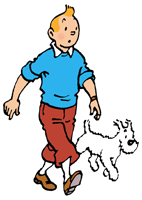Tintin (character)
| Tintin | |
|---|---|

|
|
| Publication information | |
| Publisher | Casterman (Belgium) |
| First appearance |
Tintin in the Land of the Soviets (1929) in The Adventures of Tintin |
| Created by | Hergé |
| In-story information | |
| Full name | Tintin |
| Partnerships | List of main characters |
Tintin (French pronunciation: [tɛ̃tɛ̃]) is the fictional hero of The Adventures of Tintin, the comics series by Belgian cartoonist Hergé. He is a reporter and adventurer who travels around the world with his dog Snowy. The character was created in 1929 and introduced in Le Petit Vingtième, a weekly youth supplement to the Belgian newspaper Le Vingtième Siècle. He appears as a young man, around 14 to 19 years old with a round face and quiff hairstyle. Tintin has a sharp intellect, can defend himself, and is honest, decent, compassionate, and kind. Through his investigative reporting, quick-thinking, and all-around good nature, Tintin is always able to solve the mystery and complete the adventure.
Unlike more colourful characters that he encounters, Tintin's personality is neutral, which allows the reader to not merely follow the adventures but assume Tintin's position within the story. Combined with Hergé's signature ligne claire ("clear line") style, this helps the reader "safely enter a sensually stimulating world."
Tintin's creator died in 1983, yet his creation remains a popular literary figure, even featured in a 2011 Hollywood film, directed by Steven Spielberg. Tintin has been criticised for his controversial attitudes to race and other factors, been honoured by others for his "tremendous spirit", and has prompted a few to devote their careers to his study. General Charles de Gaulle "considered Tintin his only international rival."
Hergé biographer Pierre Assouline noted that "Tintin had a prehistory", being influenced by a variety of sources that Hergé had encountered throughout his life. Hergé noted that during his early schooling in the midst of World War I, when German armies occupied Belgium, he had drawn pictures in the margins of his school workbooks of an unnamed young man battling les Boches (a slang term for the Germans). He later commented that these drawings depicted a brave and adventurous character using his intelligence and ingenuity against opponents, but none of these early drawings survive.
...
Wikipedia
